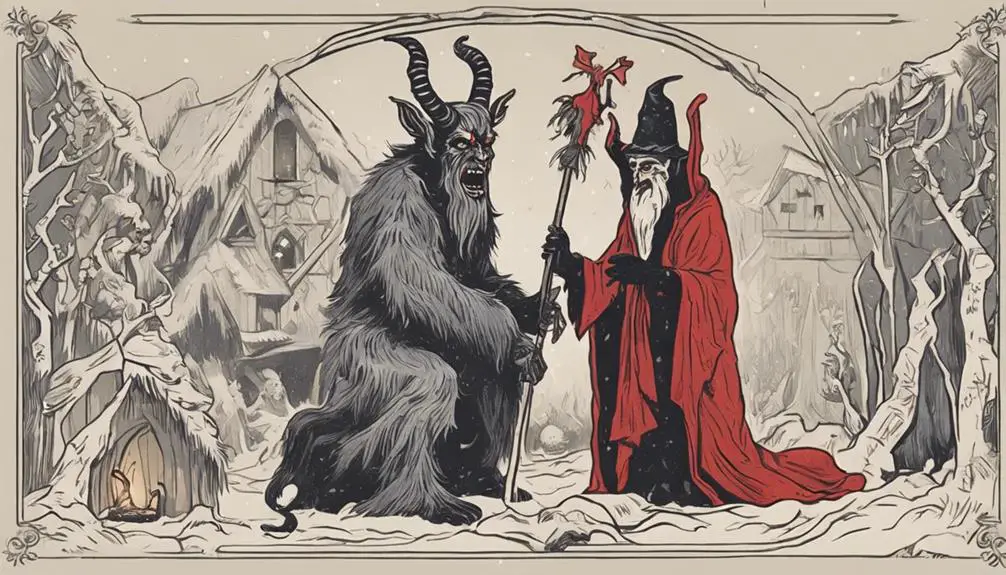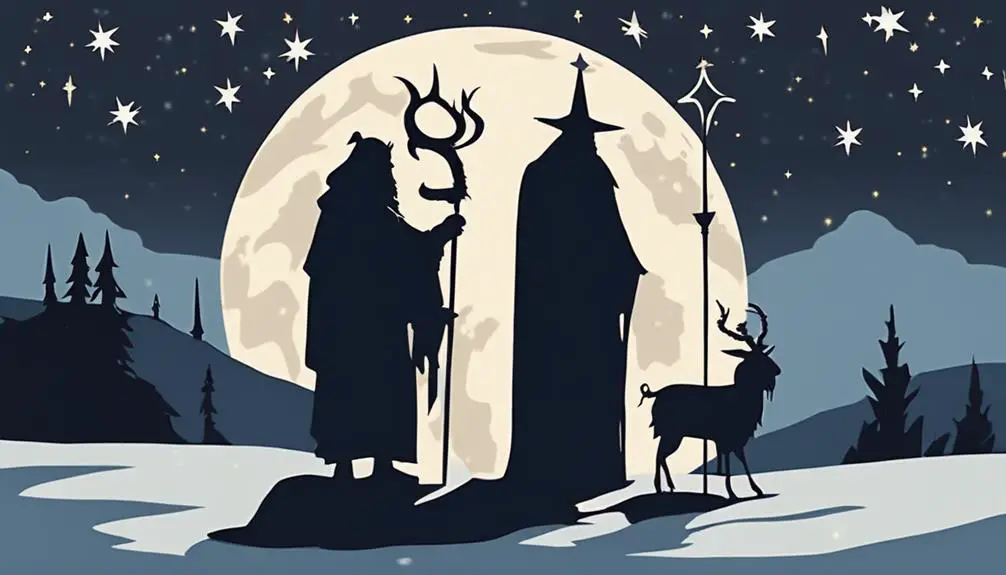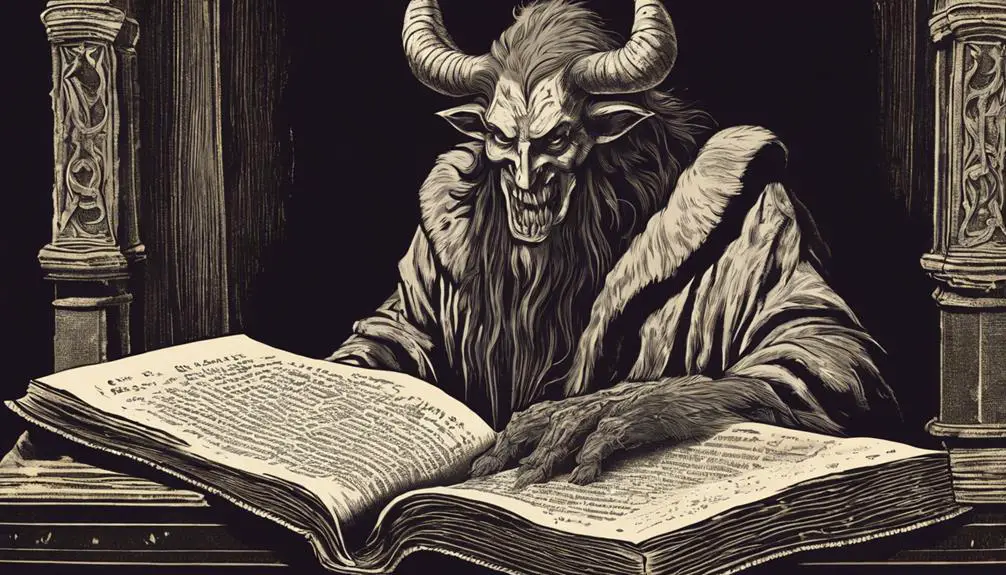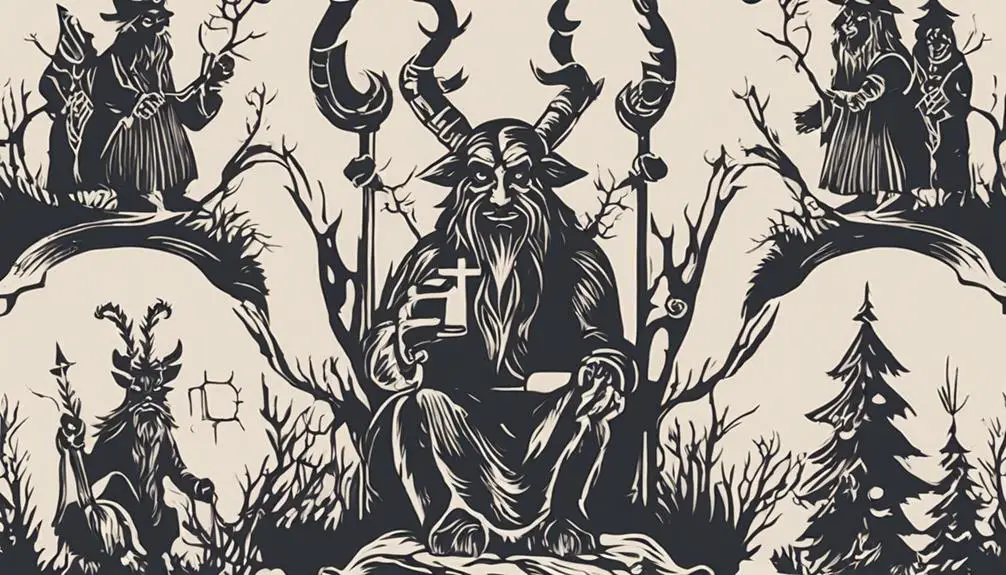Curious if the menacing figure of Krampus has biblical origins? Unravel the mystery between scripture and folklore to discover the truth.

Is Krampus in the Bible
When you think of Christmas, the figure of Santa Claus likely comes to mind, not a horned creature known as Krampus. Yet, in some European traditions, Krampus serves as a dark counterpart to Santa, punishing naughty children.
This might lead you to wonder if there's any biblical basis for such a character. While the Bible is rich with parables and symbolic creatures, the question of Krampus' presence in its texts opens up a fascinating intersection of folklore and theology.
Let's explore whether this mythical figure has roots in scripture or if he's a product of cultural evolution, beckoning you to uncover where myth ends and religious texts begin.
Key Takeaways
- Krampus is rooted in pre-Christian Alpine folklore, not in biblical texts.
- There's a clear distinction between the folklore traditions of Krampus and biblical doctrine.
- Integration of Krampus in Christian traditions does not imply its presence in the Bible.
- Cultural mythology and historical accuracy are important to differentiate when discussing Krampus's origins.
Krampus: Origins and Evolution

Krampus's origins, deeply rooted in Central European folklore, trace back to pre-Christian traditions, embodying a complex evolution that intertwines with various cultural and historical narratives. You'll find that the figure of Krampus is steeped in Alpine folklore, where he's often depicted as a counterpart to Saint Nicholas, rewarding the good while punishing the naughty. This duality reflects a deeper, more nuanced understanding of morality and justice in these communities.
Furthermore, the influence of Pagan rituals on the development of Krampus's mythology can't be overstated. These rituals, rich in symbolic meaning and communal significance, have contributed to the shaping of Krampus's image as a creature of both caution and celebration. Through seasonal festivities, the character of Krampus wasn't only a means to instill moral behavior but also served as a connection to the natural world, embodying the harshness and unpredictability of winter.
In analyzing Krampus's evolution, it's clear that his story is a mosaic of cultural amalgamation, illustrating how folklore adapts and survives through generations. As you delve deeper, you'll appreciate how Krampus's tale is a testament to the enduring power of myth in preserving ancient customs and beliefs amidst changing societal landscapes.
Biblical Figures and Mythical Creatures

Throughout history, biblical figures and mythical creatures have often been intertwined, reflecting the complex interplay between religious texts and cultural folklore. This fusion highlights the human tendency to blend the sacred with the imaginative, creating a rich tapestry of beliefs and narratives.
Angelic depictions in the Bible, for instance, showcase a blend of divine attributes with human-like qualities. These beings are portrayed as messengers of God, embodying purity and guidance, yet their visual representations often draw from the broader pool of mythical imagery. This melding of the divine with the mythical serves not only to make these celestial beings relatable but also to underscore the transcendent qualities attributed to them.
Similarly, serpent symbolism in religious texts is multifaceted, embodying both wisdom and malevolence. In many cultures, serpents are revered as creatures possessing ancient knowledge and power. The biblical narrative adopts this symbolism to represent both temptation and enlightenment, weaving a complex portrayal that resonates with broader mythical themes. This duality mirrors the human experience, encapsulating the perpetual struggle between good and evil.
Analyzing Religious Scriptures

Delving into religious scriptures reveals a layered tapestry of narratives and symbols that demand meticulous analysis and interpretation. As you navigate through ancient texts, you'll find that scripture interpretation isn't a straightforward task. It requires a deep understanding of the historical context in which these texts were written. This context shapes how symbols and narratives were understood at the time and how they should be interpreted today.
When you analyze scriptures, you're not just reading words on a page; you're uncovering the beliefs, practices, and societal norms of past civilizations. Understanding the historical context is essential because it provides insight into the mindset of the people who wrote these texts. Without this knowledge, it's easy to misinterpret messages or attribute meanings that were never intended.
Moreover, scripture interpretation involves recognizing that these texts are often written in metaphorical or symbolic language. This means you have to look beyond the literal meaning to grasp the deeper spiritual or moral message being conveyed. It's a process that demands patience, scholarly rigour, and a willingness to explore various interpretations before reaching any conclusions.
Krampus in Christian Traditions

In examining Christian traditions, one discovers that Krampus, a figure often associated with Christmas, doesn't originate from biblical texts but rather from European folklore. This distinction is crucial for understanding the role Krampus plays within the context of Christian observances, especially in regions steeped in Alpine folklore.
Krampus celebrations, deeply rooted in pre-Christian Alpine traditions, have seamlessly woven themselves into the fabric of Christian observances in some European communities. This integration raises intriguing questions about the syncretism between pagan and Christian practices. To understand the emotional and cultural impact of Krampus within these traditions, consider the following:
- Fear and Awe: Krampus embodies the juxtaposition of punishment and reward, instilling both fear and respect among participants.
- Moral Instruction: The legend of Krampus serves as a tool for moral education, emphasizing the consequences of misbehavior.
- Cultural Identity: Krampus celebrations reinforce communal bonds and cultural identity among participants.
- Festive Contrast: The figure of Krampus adds depth to the Christmas season by contrasting Saint Nicholas's benevolence with his own menacing presence.
Analytically, the inclusion of Krampus in Christian traditions showcases the dynamic interplay between folklore and religious practice, highlighting how communities adapt and reinterpret mythological elements to fit within their spiritual landscape.
Myth Vs. Scripture: the Verdict

Having explored Krampus's place within Christian traditions, let's now examine the distinction between myth and scripture to reach a clear verdict. You'll find that Krampus, as a figure, doesn't emerge from biblical texts or scriptural foundations. Instead, his origins are deeply rooted in pre-Christian Alpine folklore, illustrating a prime example of how cultural influences shape mythic characters over time.
The concept of Krampus serves as a stark illustration of the divergence between historical accuracy and mythological embellishment. Scripture, which is based on religious texts deemed sacred by believers, doesn't accommodate Krampus directly. This absence highlights the clear boundary between theological doctrine and the folklore traditions that evolve in various cultures.
In assessing Krampus's place in relation to scripture, it's crucial to acknowledge the role of cultural influences in shaping myths. These influences often reflect societal values, fears, and moral lessons, distinct from the spiritual teachings found in religious texts. Therefore, the verdict is clear: Krampus resides firmly in the realm of myth, not scripture, underscoring the importance of distinguishing between historical accuracy and the rich tapestry of cultural mythology.
Frequently Asked Questions
How Do Various Cultures Around the World Celebrate or Acknowledge Krampus-Like Figures During Their Holiday Seasons?
You'll find that throughout the world, various cultures celebrate or acknowledge Krampus-like figures during their holiday seasons. These traditions stem from diverse Krampus origins and manifest in unique cultural variations.
While exploring these customs, you'll notice a fascinating blend of folklore and tradition, where each society adapts the concept to its local beliefs and holiday practices, offering a rich tapestry of global interpretations surrounding these mythical holiday figures.
Are There Any Documented Cases or Historical Events Where Individuals Claimed to Have Encountered Krampus or a Similar Entity in Real Life?
You're asking if there have been real-life encounters with Krampus or similar entities. While historical documentation on Krampus origins doesn't explicitly record such encounters, various cultural anecdotes suggest people have claimed to experience them.
Encounter methods often involve vivid dreams or eerie sightings during specific festive seasons. These accounts, while not scientifically verified, contribute to the folklore surrounding Krampus, illustrating how myth and reality often intertwine in human experiences.
How Has the Depiction of Krampus in Modern Media, Such as Movies and Literature, Influenced Public Perception of Traditional Folklore?
You'll find that modern media's portrayal of Krampus significantly shapes public perception, often straying from Krampus origins in folklore. This media misinterpretation introduces a more sensational, sometimes less nuanced figure than traditionally understood.
As movies and literature reimagine Krampus, they blend and sometimes distort the original tales, leading to a broader, yet potentially less accurate, recognition of this figure in contemporary culture, influencing how traditional folklore is perceived globally.
What Psychological or Sociological Explanations Exist for the Creation and Perpetuation of the Krampus Legend in Communities?
You're exploring why communities have created and kept the Krampus legend alive.
It's about the fear factor and cultural evolution.
Sociologically, Krampus serves as a tool for social control, leveraging fear to enforce norms.
Psychologically, it taps into deep-seated anxieties, providing a safe outlet for processing these fears.
As cultures evolve, so does Krampus, adapting to continue resonating with societal values and fears, ensuring its perpetuation through generations.
How Do Contemporary Pagan or Neo-Pagan Practices Incorporate Krampus or Similar Figures Into Their Rituals and Beliefs?
You'll find that modern pagan or neo-pagan practices often weave Krampus or similar entities into their ceremonies, drawing deeply on pagan symbolism. These figures embody aspects of nature, fertility, and the cycle of life and death, enriching rituals with profound significance.
Their inclusion serves not just for spectacle but roots practices in ancient traditions, highlighting the ritual significance of these beings in promoting balance, respect for nature, and community cohesion.
Conclusion
In conclusion, while you might think Krampus has biblical roots due to his appearance in Christian traditions, analysis reveals no direct link in religious scriptures. Krampus evolved from pre-Christian lore, embodying a stark contrast to biblical figures. This distinction clarifies the separation between myth and scripture, underscoring the importance of understanding cultural evolution in religious practices.
Thus, despite the anticipated objection that all Christian traditions have biblical origins, Krampus's story serves as a compelling example of external influences shaping religious celebrations.



Sign up